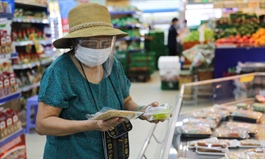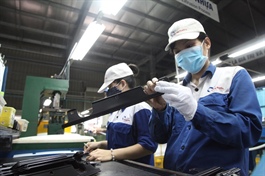Viet Nam’s third quarter GDP down 6.7 per cent: lowest quarterly decline since 2000
Viet Nam’s third quarter GDP down 6.7 per cent: lowest quarterly decline since 2000
Viet Nam witnessed a steep decline in gross domestic product (GDP) of 6.7 per cent in the third quarter of this year, the General Statistics Office said on Wednesday.

This is the lowest quarterly decline recorded in the history of quarterly GDP statistics since 2000.
GSO General Director Nguyen Thi Huong said at a press conference in Ha Noi that the GDP growth was dragged down by the deeply-felt impacts of the fourth wave of the COVID-19 pandemic.
“The negative GDP growth in the third quarter is predictable as in the past three months, many localities across the country had to follow strict social distancing measures, thus halting production,” she said.
In Q3, the agro-forestry-fishery sector rose by 1.04 per cent, industry and construction fell by 5.02 per cent and the services sector was down 9.28 per cent, statistics showed.
In the first nine months of this year, Viet Nam’s GDP still expanded 1.42 per cent compared to the same period last year.
Amid the COVID-19 pandemic’s serious impact on every socio-economic aspect of countries around the world, it was still a big success of Viet Nam in the pandemic fight and economic recovery and development, she said.
Between January and September, the agro-forestry-fishery sector increased 2.74 per cent, industry-construction 3.57 per cent, and services 0.69 per cent. The first two respectively contributed 23.52 per cent, 98.53 per cent to the overall growth while the third contributed to reducing overall growth 22.05 per cent.
Huong said the agro-forestry-fisheries sector played the role of a pedestal of the economic growth during the pandemic, with high rice productivity, stable livestock production growth and fairly high export turnover in some agricultural products.
The agricultural sector increased by 3.32 per cent in nine months, the forestry sector expanded by 3.3 per cent and the fisheries sector rose by 0.66 per cent.
In the industry-construction group, the processing and manufacturing industry was the growth engine of the whole economy with a growth rate of 6.05 per cent, Huong said.
According to the GSO, the COVID-19 pandemic has seriously affected trade and service activities. Some service industries with negative growth contributed to reducing the overall growth of the whole economy.
Of them, the wholesale and retail sector fell by 3.1 per cent, the transportation and warehousing industry decreased by 7.79 per cent and the accommodation and food service industry dropped by 23.18 per cent.
The health sector, in contrast, achieved the highest growth rate with a sharp increase of 21.15 per cent, followed by the financial, banking and insurance industry with an increase of 8.37 per cent and information and communication, up by 5.24 per cent.
CPI down 0.62 per cent in September
The consumer price index (CPI) in September decreased by 0.62 per cent compared to August but was up by 2.06 per cent compared to the same period last year.
Huong attributed the decrease in monthly CPI to the decrease in rental housing prices during the implementation of social distancing, the exemption and reduction in tuition fees for the academic year 2021-2022 in some localities, falling food prices due to guaranteed supply and the Government’s plan to reduce electricity prices for households and businesses affected by the COVID-19 epidemic.
Six of the 11 groups of commodities and services increased, of which beverage and tobacco rose 0.17 per cent, household appliance gained 0.09 per cent, garments, hats and footwear climbed 0.02 per cent, culture, entertainment and tourism rose 0.01 per cent, medicine and medical service increased 0.03 per cent, commodities and other services were up 0.02 per cent.
Five groups decreased, including housing and construction materials declining 1.99 per cent, education dropping 2.89 per cent, traffic down 0.16 per cent, food and catering services losing 0.16 per cent, post and telecommunications, dropping 0.06 per cent.
In nine months, CPI increased by 1.82 per cent compared to the same period last year, the lowest nine-month CPI growth recorded since 2016. Core inflation in 9 months rose by 0.88 per cent.



















